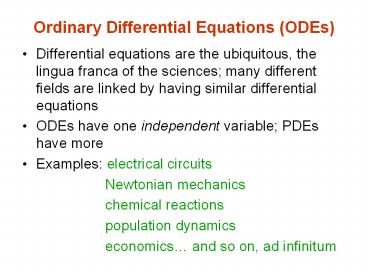Ordinary Differential Equations (ODEs) - PowerPoint PPT Presentation
Title:
Ordinary Differential Equations (ODEs)
Description:
Differential equations are the ubiquitous, the lingua franca ... Euler's Method simple-minded, basis of many others. Predictor-corrector methods can be useful ... – PowerPoint PPT presentation
Number of Views:204
Avg rating:3.0/5.0
Title: Ordinary Differential Equations (ODEs)
1
Ordinary Differential Equations (ODEs)
- Differential equations are the ubiquitous, the
lingua franca of the sciences many different
fields are linked by having similar differential
equations - ODEs have one independent variable PDEs have
more - Examples electrical circuits
- Newtonian mechanics
- chemical reactions
- population dynamics
- economics and so on, ad
infinitum
2
Example RLC circuit
3
To illustrate Population dynamics
- 1798 Malthusian catastrophe
- 1838 Verhulst, logistic growth
- Predator-prey systems, Volterra-Lotka
4
Population dynamics
- Malthus
- Verhulst
- Logistic growth
?
?
5
Population dynamics
Hudson Bay Company
6
Population dynamics
V .Volterra, commercial fishing in the Adriatic
7
In the x1-x2 plane
8
State space
Integrate analytically!
Produces a family of concentric closed curves as
shown How to compute?
9
Population dynamics
self-limiting term
? stable focus
Delay ? limit cycle
10
As functions of time
11
Do you believe this?
- Do hares eat lynx, Gilpin 1973
Do Hares Eat Lynx? Michael E. Gilpin The
American Naturalist, Vol. 107, No. 957 (Sep. -
Oct., 1973), pp. 727-730 Published by The
University of Chicago Press for The American
Society of Naturalists Stable URL
http//www.jstor.org/stable/2459670
12
Putting equations in state-space form
?
13
Traditional state space
Example the (nonlinear) pendulum
McMaster
14
Linear pendulum small ?
For simplicity, let g/l 1
Circles!
15
Pendulum in the phase plane
16
Varieties of Behavior
- Stable focus
- Periodic
- Limit cycle
17
Varieties of Behavior
- Stable focus
- Periodic
- Limit cycle
- Chaos
- Assignment
18
Numerical integration of ODEs
- Eulers Method ? simple-minded, basis of
many others - Predictor-corrector methods ? can be useful
- Runge-Kutta (usually 4th-order) ?workhorse, good
enough for our work, but not state-of-the-art
19
Criteria for evaluating
- Accuracy ? use Taylor series, big-Oh, classical
numerical analysis - Efficiency ? running time may be hard to predict,
sometimes step size is adaptive - Stability ? some methods diverge on some problems
20
Euler
- Local error O(h2)
- Global accumulated) error O(h)
(Roughly multiply by T/h )
21
Euler
- Local error O(h2)
- Global (accumulated) error O(h)
Euler step
22
Euler
- Local error O(h2)
- Global (accumulated) error O(h)
Taylors series with remainder
Euler step
23
Second-order Runge-Kutta (midpoint method)
- Local error O(h3)
- Global (accumulated) error O(h2)
24
Fourth-order Runge-Kutta
- Local error O(h5)
- Global (accumulated) error O(h4)
25
Additional topics
- Stability, stiff systems
- Implicit methods
- Two-point boundary-value problems
- shooting methods
- relaxation methods































